
pedestrians ● cyclists ● drivers
LOOK OUT for our innovative NEW pedestrian and bikeway infrastructure and learn how to safely navigate these traffic patterns and road markings in Montgomery County.
These changes to the roads make it safer for everyone by designating space for cyclists, improving drivers' ability to see cyclists, and clarifying where people should walk and cross streets or bikeways safely.
We want everybody to feel comfortable using public space regardless if they choose to drive, bike or walk to their destination. We are striving to make our roadways safer for everyone no matter their age or abilities. Safety should be everyone’s priority!
› View Informational VideoInteractive Infographic
Click red dots below to learn how to navigate new traffic patterns and road markings.

Bike Box
A bike box is a designated area at the front of a traffic lane that provides cyclists a safe and visible way to get ahead of vehicles at a red light.
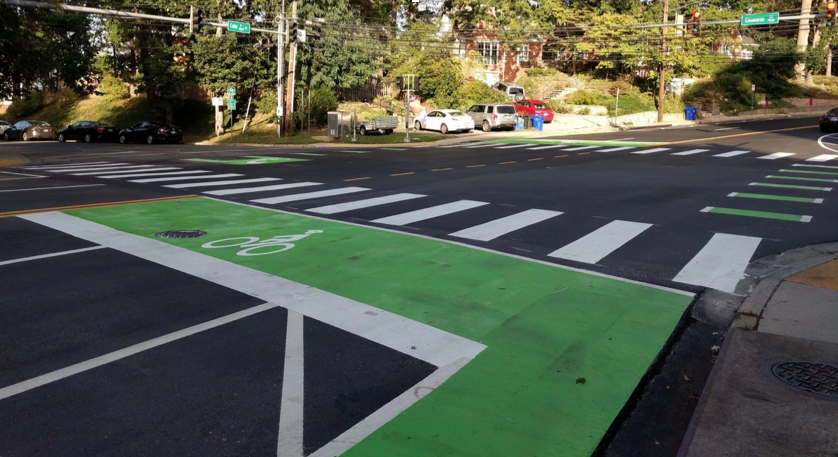
Instructions for...
Drivers
Wait behind the green bike box; do not cross into the green.
Cyclists will fill in the green bike box in front of you. When the light turns green, cyclists will go through the intersection first. Note: Right turn is only allowed when the light is green; right on red is not permitted. When turning right, watch for and yield to cyclists going straight. Cyclists must obey all of the same traffic laws as motorists.
Bike boxes allow everyone, including drivers, to get through the intersection more quickly, by moving cyclists efficiently through an intersection.
Cyclists
From the bike lane, enter the bike box and wait for the light to turn green. Once you are through the intersection, merge back into the bike lane.
Cyclists may spread out in the bike box to maximize visibility. Avoid encroaching into the pedestrian crosswalk.
The bike box may also be used for left turns (yielding to approaching traffic).
Cyclists must obey all of the same traffic laws as motorists.
Pedestrians
Look out for cyclists and motorists who are navigating a new traffic pattern.
Cross within the designated crosswalk. Avoid walking in the green marking areas reserved for cyclists
The bike box pushes the stop line back and away from the crosswalk, reducing the risk that drivers encroach on the crosswalk.
Cyclists must obey all of the same traffic laws as motorists.
Pocket Lane
Pocket Lanes are short areas of bike lanes that allow cyclists to continue straight ahead without having a conflict with right turning vehicles at the intersection. In some locations, flexposts to the left of the bike lane discourage drivers from crossing over the bike lane in the queuing area.
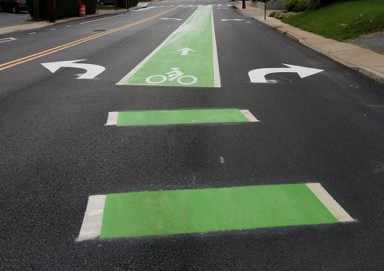
Instructions for...
Drivers
The solid green pavement area is an exclusive area for cyclists. Move to the side of a pocket lane (left or right depending on your direction of travel) before approaching the solid green pavement and do not enter the solid green pavement area at any time.
The solid green pavement area should alert motorists to expect cyclists entering the pocket lane and to maintain caution approaching the intersection.
Cyclists
When moving through the traffic, enter the designated area to move past stopped vehicles. Turning cyclists should use the appropriate lane or a turn queue box if present.
Pedestrians
Avoid walking in the areas with green markings.
Green Pavement
Green pavement areas are exclusively for use by cyclists. Drivers and pedestrians should avoid entering areas with green markings except to carefully crossover where necessary.

Instructions for...
Drivers
The solid green pavement area is an exclusive area for cyclists. Drivers should never drive in, stop in, or park in a bike lane.
Cyclists
The solid green pavement area is an exclusive area for cyclists. Be aware that you may be sharing the bike lane with cyclists traveling in the opposite direction. You should always ride in the designated direction.
Pedestrians
Look out for cyclists and look both ways before crossing the bikeway. Avoid walking or standing in the green pavement areas.
Two-Stage Turn Queue Box
A turn queue box is a designated space for cyclists to wait when turning left, or in some cases, right, from a bike lane at a multi-lane intersection.
This allows cyclists to turn from the same side of the street as the bike lane, without merging across multiple lanes of traffic when turning.
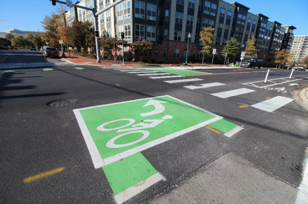
Instructions for...
Drivers
Stop behind the crosswalk or stop line. Cyclists will enter the box as a safe place to wait when making a turn through the intersection. When the light turns green, the cyclists in the turn queue box will go through the intersection first.
Look out for cyclists in the turn queue box when turning or proceeding straight through the intersection.
Drivers benefit from this because cyclists will not need to cross in front of vehicle traffic.
Cyclists
To make a left turn, enter the turn queue box in the bike lane. Turn to face your intended direction of travel. When the light turns green, proceed across the intersection ahead of the waiting vehicles.
Turn queue boxes minimize exposure to conflict with vehicles for cyclists.
Pedestrians
Look out for cyclists and motorists who are navigating a new traffic pattern.
Avoid walking in areas with green markings.
Floating Bus Stop
A floating bus stop is a dedicated waiting and boarding area for bus passengers between the bike lane and the travel lanes. The bus platform is called a “floating” stop because it “floats” away from the curb and is not directly attached to the sidewalk. The boarding areas are islands – they are separated from the sidewalk by a bike lane.
These floating bus stops mean that the bus does not have to enter the bike lane to pick up and discharge passengers. The platform also separates cyclists from vehicles. Bus passengers should look out for cyclists when crossing the bike lane to enter the floating bus stop.
The bus platform is wide enough to accommodate people with mobility devices and for passengers to wait for the bus. Some platforms will include a bus shelter and bench, while others will not.
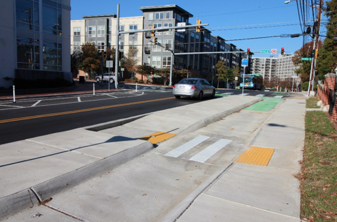
Instructions for...
Drivers
Look out for raised concrete islands and stopped buses in the lane of traffic.
Cyclists
Look out for pedestrians crossing the bike lane to get to and from the bus stop. Pedestrians have the right-of-way in these locations, and you must yield.
Pedestrians
Look out for cyclists when crossing the bike lane. Look both ways before crossing the bikeway.
BUS RIDERS
When getting off a bus, look out for oncoming cyclists and always use marked crosswalks to cross the street.
1- and 2- Way Separated Bike Lanes
Separated bike lanes are bike lanes that are separated from traffic using some form of vertical and/or horizontal barrier. These can be either one-way separated bike lanes or two-way separated bike lanes (two-way facilities may also be known as “cycletracks”).
Flexposts are often used as a barrier, but other types of barriers may be used, including curbs or planters. Flexposts are usually plastic and will not provide a physical barrier for vehicles. Separated bike lanes do not provide shared space for pedestrians; nearby sidewalks are provided for pedestrians.
Separated bike lanes may be on either side of the street.

Instructions for...
Drivers
Drivers should never drive in, stop in, or park in a separated bike lane.
When on-street parking is present, it will be located between the bike lane and the travel lane. Do not park in the bike lane.
If parking meters are present, you must pay to park during meter enforcement hours.
When parking next to a separated bike lane, drivers and passengers should look out for cyclists and be careful to not open doors into the path of a cyclist. Additionally, when crossing the bike lane to get to the sidewalk or parking meter, look both ways before stepping into the bike lane.
Cyclists
Be aware that you may be sharing the bike lane with cyclists traveling in the opposite direction.
While the buffer reduces the risk of cyclists being “doored” by drivers in parked vehicles, you should still look out for opening doors and people crossing the bike lane to reach the curb.
You should always ride in the designated direction in a one-way separated bike lane. You may overtake and pass a cyclist moving in the same direction if there is space to do so.
In a two-way separated bike lane, you should always ride to the right. When the yellow line is dashed, if it safe to do so, you may pass a cyclist moving in the same direction, but you should yield to oncoming cyclists and look out to avoid a collision. Do not cross a solid yellow line.
Pedestrians
Look out for cyclists when crossing the bike lane. Look both ways before crossing the bikeway.
Avoid walking in the green pavement areas.
The separated bike lanes will provide an additional buffer between you and traffic.
Parking Along a Bike Lane
In certain areas, parking lanes may be located next to the bike lanes. Flexposts are often used to make the separation between the bike and vehicle lanes visible. Drivers and passengers should yield to cyclists when accessing a parked vehicle or crossing bike lanes, and should exercise caution when opening doors into a travel or bike lane.
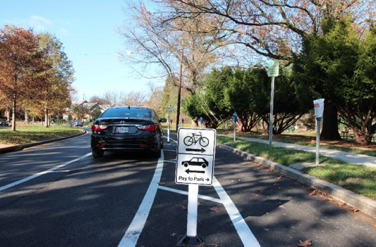
Instructions for...
Drivers
When on-street parking is present, it will be located between the bike lane and the travel lane. Park in the parking lane - Do not park in the bike lane.
If parking meters are present, you must pay to park during meter enforcement hours.
When parking next to a separated bike lane, drivers and passengers should look out for cyclists and be careful to not open doors into the path of a cyclist. Additionally, when crossing the bike lane to get to the sidewalk or parking meter, look both ways before stepping into the bike lane.
Cyclists
Watch for car doors opening when passing parked cars along a bikeway.
Pedestrians
Look out for cyclists when crossing a bike lane or when accessing or exiting a vehicle parked next to a bike lane.
Mixing and Conflict Zones
Mixing zones allow cyclists and drivers to cross each others' paths ahead of a turn or at a driveway. They are indicated by dashed green markings. Cyclists have the right-of-way in these locations.

Instructions for...
Drivers
Make sure to look out for cyclists coming from both directions. Some mixing zones are two-way, so cyclists may be coming toward you in addition to those riding in the same direction.
When turning, look out for cyclists on your right before crossing over the dashed green bike lane.
At some intersections, when a right turn lane is present, cross over the green dashed bike lane before the intersection. Turn from the right side of the bike lane.
At driveways and locations where there is not a right turn lane, look out for and yield to cyclists when you turn across the green dashed lines.
Reminder: Vehicles may cross over, but not drive for any length along, dashed green marked areas.
Cyclists
Look out for vehicles that may be crossing over the bike lane.
Cyclists have the right-of-way in these locations, however, look out for motorists in these areas, and exercise caution.
Pedestrians
Look out for drivers and cyclists turning into the crosswalk.
Avoid walking in the areas with green markings.
Signs and Signals
New bike traffic signals are being installed at some intersections. Bicycle traffic signals provide guidance for bicyclists at intersections where they may have different needs from other road users.
- Cyclists may be directed to use vehicular signals, bike signals, or pedestrian signals by signage at intersections.
- Drivers may turn across cycle tracks and bike lanes after signaling and yielding, unless there is a "No Right Turn on Red" sign.
- Everyone must all follow traffic laws and obey and signs and signals.
All users should look out for each other at signal locations, regardless of the signs and signals shown
Bike hand Signals:
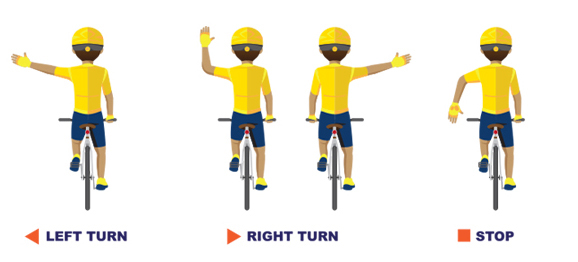

General Tips for Cyclists
- Stay to the right except when passing.
- Travel at a reasonable speed in a consistent and predictable manner.
- Always look out – ahead and behind before passing.
- Pass slower traffic cautiously on the left; yield to oncoming traffic when passing.
- Give a clear warning signal before passing (ring a bell and verbal notification).
- Move off the bikeway when stopped to allow others room to pass.
- When riding at dusk, dawn and after dark, use a headlight and a red rear light. *
- Helmets are a good idea for all cyclists. Cyclists under the age of 18 * * are required to wear a bicycle safety helmet in Montgomery County and under the age of 16 elsewhere in Maryland. *
- Obey all traffic signs and signals. *
- Yield to other users when entering and crossing a bikeway. *
- Stop for traffic when a bikeway crosses a roadway. *
- Always use hand signals when turning. *
- Look out for all your fellow travelers, whether they are cyclists, pedestrians or motorists
* Indicates Maryland Traffic Laws
*
* Indicates Montgomery County Law
General Tips for Drivers
- Stay at least three (3) feet * from a bicycle; always keep a safe distance.
- Travel at a reasonable speed in a consistent and predictable manner.
- Yield to cyclists and pedestrians when driving through an intersection. Look for cyclists coming from both directions.
- Use courtesy when passing a cyclist and leave plenty of space, like you would with any other vehicle.
- Look before opening the door of your vehicle to avoid colliding with a pedestrian or cyclist.
- More cyclists on the road means fewer cars on the road. This is a benefit to our community – easing traffic congestion as well as the carbon footprint.
- Remember, a cyclist might be someone you know – family, neighbors, friends and colleagues. Look out for all your fellow travelers and be respectful.
* Indicates Maryland Traffic Laws
About the Project
TLC grant
MCDOT Bikeways
MCDOT BiPPA
State laws bike
Montgomery County has new traffic patterns and infrastructure in several areas where the enhancement of pedestrian and cyclist traffic and safety has been designated a priority. These areas support cohesive neighborhoods and create vibrant communities.
This project was supported by the National Capital Region Transportation Planning Board’s Transportation Land-Use Connection (TLC) Program.
